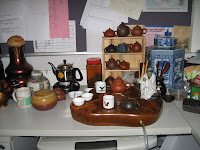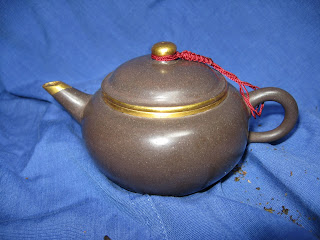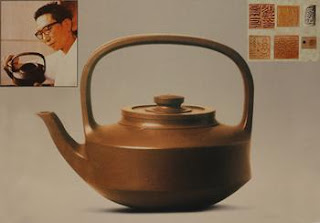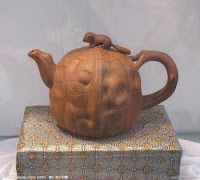 |
| Quality Puerh tea |
Do you want a cup of kungfu tea (功夫茶)? People of different culture may think that this is the favourite tea of Jacky Chan or Jet Lee, both are world renowned kungfu (功夫) actors. Actually kungfu tea refers to a very old Chinese tea ceremony originated in Fujian. This type of tea drinking ceremony has influenced many parts of S E Asia where there are Chinese community of Fujian (Hokkien) origin. Kungfu, in Chinese language, apart from kungfu fighting, it means effort. So drinking kungfu tea literally means ' drinking tea made with effort'. This process involves the ritualised preparation and presentation of tea to maximize its fragrance and taste, especially serving a fine tea from China and Taiwan.
To make kungfu tea, apart from quality tea leaves, one must also pay particular attention to equipment used, water chemistry and temperature, and the manner tea is served to guests. In essence, what is desired in kungfu tea is a brew that smells and tastes good and is satisfying to the soul. Since the process is quite laborious, it may take from 10 to 20 minutes just to prepare 4 to 8 small cups of tea using teapots of appropriate size. Equipment generally consists of kettle, teapot (or covered bowl), tea spoon (for moving tea leaves into the pot) decanting vessel, strainer, tea pick (to clear the sprout of teapot), drip tray, cups (longer cups are for sniffing the fragrance of tea, shorter ones are for drinking) and tea towel. Water quality is another issue not to neglect. The best water to brew tea is clean water from mountain streams (one can use bottled mineral water instead), most people use tap water which is readily available. For Puerh tea, water temperature should be boiling but for most green teas (oolong or dragon well), temperature should be lower as the tea leaves are more delicate (80 to 90 degrees depending on tea). Tea experts normally observe the bubbles of the boiling water to tell its temperature. Small teapots are used as the tea is served in small cups. The teapots come in sizes to fill 2 cups, 4 cups
 |
| Tea cups for serving kungfu tea |
and up to 8 cups. Usually teapots to fill 4 cups are ideal for kungfu tea.
 |
| Ideal teapot for kungfu tea |
 |
| My set of equipment for making tea |
The kungfu tea ceremony should be carried out on a table large enough to hold the tea-making utensils, the drip tray, and the water is the minimum necessary. Ideally the surroundings should be peaceful and conducive to relaxation and socialization. Incense, flowers, and low, soft, traditional music will all add to the ambience, as will songbirds. The whole process can be summarised as follows:
The first stage of preparation is to warm the teapot and heat up the cups using hot boiling water to sterilize them. Wooden tweezers may be used instead of bare hands for handling the cups.
The second stage is to examine and appreciate the appearance, smell, and other characteristics of the tea used during the ceremony.
The third stage is to fill the teapot with tea. For a 150 ml tea pot at least 15 grams of tea leaves are used, however depending on the size of the pot and the strength of the tea the pot may be filled between 1/2 and 2/3 full.
Next, the leaves are now rinsed using hot water poured from some height above the teapot. Water heated to the appropriate temperature for the tea is then poured into the pot until the pot overflows. Any debris or bubbles which form on the surface are then scooped away gently and the teapot is then closed with the lid. Customarily this first brew is poured into the cups but is not drunk. Some may use the first brew to pour over outside of the teapot.
The teapot is then refilled with fresh hot water until the water reaches the mouth of the pot. To brew the tea, hot water is poured closer to the leaves in order not to force the flavour from the leaves too rapidly. When the brew is ready (usually this takes a couple of minutes) the tea is then poured evenly into the tea cups, in a circular manner around the guests. In some styles, however, often the tea is first emptied into the tea pitcher (decanter) before being poured into the cups to serve the guests. A quality oolong tea is good for anywhere from 4 to 8 infusions. Some Puerh teas can last for 8 or more infusions. Each subsequent brew follows the same procedure, but requires a slightly longer infusion time.
Before drinking the tea, the aroma of the tea is enjoyed first before its taste. In this case, the tea is first poured into the tea jug, and then into scent cups (聞香杯), or sniffer cup. As the scent cups can still be hot, one can always roll the cup to and fro in his palm to lower the temperature before smelling the nice fragrance of tea smell still linger in the cup (of course after the tea is emptied into the drinking cup).
After enjoying the scent of the tea, the guest can then drink his tea in three sips, no less; the first a small one, the second the main one, and the last an after taste.
The ceremony ends with the used tea leaves being put into a clean bowl for the guests to appreciate the tea in its used form. Good etiquette dictates that the guests should make appropriate compliments regarding the choice of tea.
Cleaning up is an important step in the ritual. Brewed tea and tea leaves should not remain in the teapot after the ritual. The pot must be cleaned up thoroughly and rinsed with hot tea. Utensils must be sterilized with boiling water. The teapot should be rinsed with hot tea and the outside should be rubbed and polished with a good linen cloth. A clay teapot should never be washed with detergents or soaps. The teapot must be allowed to dry naturally.
The above procedure may look rather elaborate. This often put off beginners to appreciate the joy of drinking fine Chinese tea. However, one can always modify the steps to suit one's style and convenience. The may issue is to enjoy the a cup of good Chinese tea. Do not let any complicated tea ritual hinder your love of drinking Chinese tea. For most busy professionals, time is crucial. I keep a very simple set of equipment to brew Chinese tea in my office. A kettle, some teapots, tea cups and spoon, a jug and a wooden drip tray that has a plastic tube to drain used water into a bucket kept below the table. This will very much simplify the whole tea making process and give me more time to enjoy more tea.
 |
| Polished Yixing teapot of the 19th century |
 |
Polished teapot with gold finishes
|






























